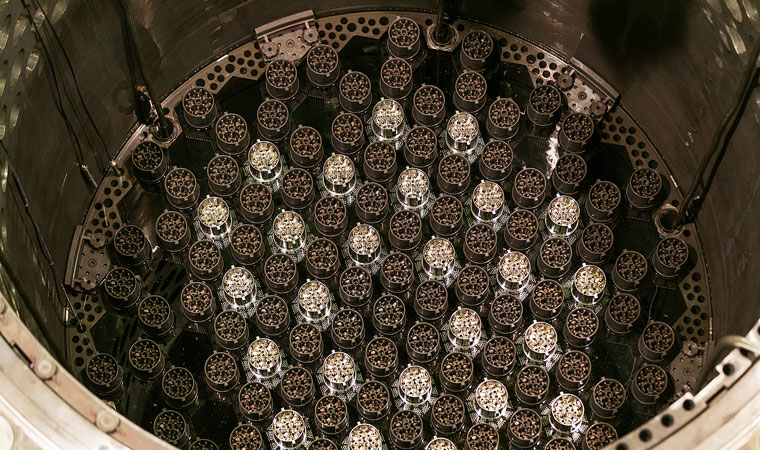
Reactor startup and other news
back to contentsNovovoronezh NPP
The first fuel assembly was loaded into the reactor core at Novovoronezh NPP Unit 6 on the 24th of March to mark the beginning of the reactor startup process. Before fuel loading, the nuclear station obtained an operating permit from the Russian regulator Rostechnadzor. The loading process is also supervised by the regulator.
Technically, Unit 6 was ready for the startup already in winter after all the cold and hot functional tests were completed in December and all system parameters verified. Right after that, nuclear fuel was delivered to the site and, following the incoming acceptance, placed into a recently commissioned fresh fuel storage facility.
Safety is the main requirement to the new power unit start-up, says Novovoronezh Plant Manager Vladimir Povarov. At the stage of first criticality, to ensure additional safety, fuel assembly dummies were loaded into the core and the neutron flux monitoring instrumentation was installed.
He also explained that such loading pattern was radically different from those which had been used at pilot power units before. “It is not standard load at all. We load nuclear fuel into the core, which is partly filled with fuel assembly dummies, for the first time, to enhance safety,” he said. The Plant Manager expressed his assurance that this power unit would become a reference one and would facilitate dynamic development of nuclear power.
Fedor Tatarkin, Leading Engineer from the Novovoronezh Branch of JSC Atomtekhenergo and Head On-Duty of the first standard loading, explained that the loading operation was structured so that at the first stage fresh fuel comprised about one third of all loaded assemblies, the rest are FA dummies. Then, the fuel will be loaded one-by-one instead of fuel assembly dummies in the remaining cells in accordance with the operating schedule.
Further plans are to start the installation of steam generators in March and mount the upper section of the containment dome at Unit 7.
Rostov NPP
Rostov NPP Unit 4, now under construction, has entered a pre-commissioning phase. Eight rooms with control and measurement equipment were assigned an ‘operating’ status. Alexander Belyaev, a deputy chief engineer for maintenance and operations, explains, “The operating status means that construction has been finished in relevant rooms. Facilities with this status are transferred to the operating personnel and fall under the responsibility of the control and automation department. It is now this department that will ensure safety during the pre-commissioning phase.”
Another process now underway at Unit 4 is the main circulation circuit welding. Four teams of 36 most professional welders are working on 28 circuit joints. They will have to outperform their Novovoronezh colleagues who did the same job at Unit 6 for just 102 days. In 2013, welding on the main circulation circuit of Rostov Unit 3 was completed in 143 days.
Plans for the near future are to start the installation of a main circulation pump and a fuel loader. A key item on the current year’s agenda is leak detection and non-pressure tests of the reactor piping. Unit 4 is scheduled for the startup in 2017.
Leningrad NPP-2
Construction of the first VVER-based reactor unit has entered the homestretch. Earlier this year, the construction team began the installation of electric systems on the ramp crane designed to move cargo, fresh and spent nuclear fuel from and into the containment. Construction of the outer reactor building is nearing completion.
The contractor has yet to build an in-situ slab structure. This task will require the building team to mount steel bearing beams (channels), fix them on the outer walls, install the formwork, assemble reinforcement, concrete the slab and ensure proper conditions for the concrete curing until it reaches the designed strength.
“The slab structure is an upper enclosure of the outer reactor building and is intended to withstand high static and dynamic loads and protect the reactor from external impacts. This is the reason why requirements for the structure are so stringent. It will be cast with the use of self-supporting demountable formwork bearing wet concrete, wind and installation loads,” Head of Technology Supervision at Leningrad NPP-2 Kirill Mazurin explains.
Embedded items have been installed in the airlock foundation slab. Two 8-meter steel rings were put on the bearing structures at Level +26 and welded to the bracing structures of inner and outer reactor building walls. After the core equipment is mounted, an airlock will be installed, with embedded items to fix it in place.
Kursk NPP–2
The Kursk nuclear power plant will feature VVER-TOI reactors. First of all, we should dispel rumors that the construction has been suspended. On-site work is going full tilt. The building team is performing on-site excavation and erecting auxiliary construction facilities. Access roads are being constructed to link the site with the railway. An automobile bridge over the Seym River will be commissioned in June. Another important task for the current year is to obtain a construction permit for two reactor units.
Project finance for this year has been provided in full. Construction and installation alone will require 4 billion rubles. The administrative team is drafting documents to make an advance payment for long lead-time equipment.
Smolensk NPP
RosEnergoAtom is considering a plan for the construction of a nuclear station to replace the existing Smolensk nuclear power plant. The Russian regulator Rostechnadzor is expected to issue a license for Smolensk NPP-2 in September. This year’s priority is to rezone the site land from forest to industrial and have the site survey approved by the regulator. The first VVER TOI based unit of Smolensk NPP-2 is planned to be commissioned in 2027.




